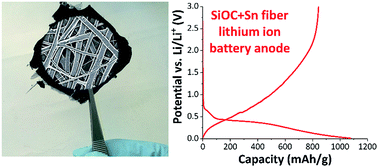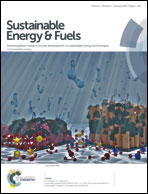Continuous silicon oxycarbide fiber mats with tin nanoparticles as a high capacity anode for lithium-ion batteries†
Abstract
Continuous fiber mats are attractive electrodes for lithium-ion batteries, because they allow operation at high charge/discharge rates in addition to being free of polymer binders and conductive additives. In this work, we synthesize and characterize continuous Sn/SiOC fibers (diameter ca. 0.95 μm), as a Li-ion battery anode. Our synthesis employs electrospinning of a low-cost silicone resin, using tin acetate in a dual role both as a polymer crosslinker and as a tin precursor (6–22 mass%). The hybrid electrodes present very high initial reversible capacities (840–994 mA h g−1) at 35 mA g−1, and retain 280–310 mA h g−1 at 350 mA g−1. After 100 cycles at 70 mA g−1, the hybrid fibers maintained 400–509 mA h g−1. Adding low amounts of Sn is beneficial not just for the crosslinking of the polymer precursor, but also to decrease the presence of electrochemically inactive silicon carbide domains within the SiOC fibers. Also, the metallic tin clusters contribute to a higher Li+ insertion in the first cycles. However, high amounts of Sn decrease the electrochemical performance stability. In SiOC fibers synthesized at high temperatures (1200 °C), the Cfree phase has a significant influence on the stability of the system, by compensating for the volume expansion from the alloying systems (Sn and SiO2), and improving the conductivity of the hybrid system. Therefore, a high amount of carbon and a high graphitization degree are crucial for a high conductivity and a stable electrochemical performance.



 Please wait while we load your content...
Please wait while we load your content...